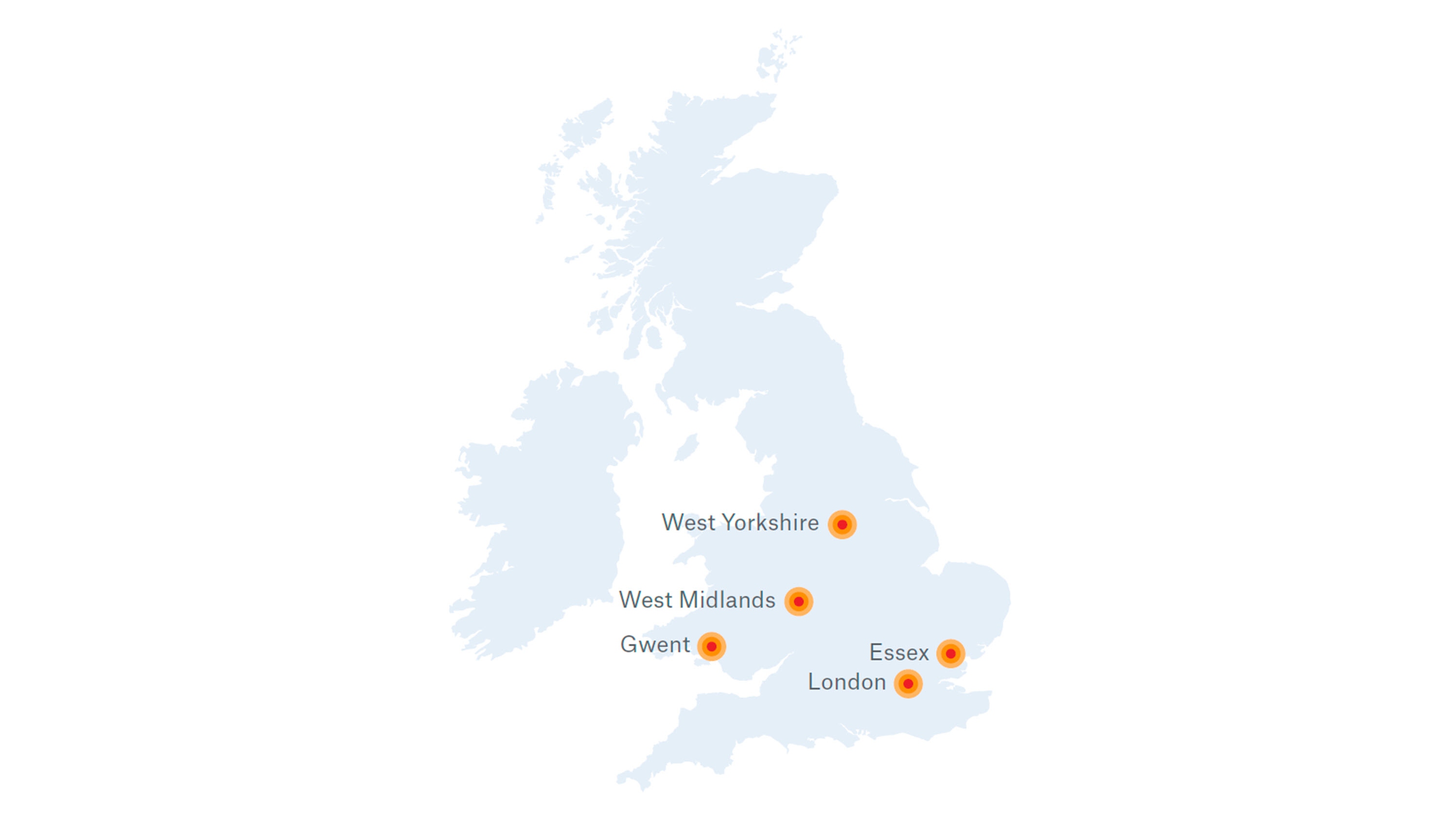
UK construction trends
Industry report
Five key trends that are influencing the construction market and impacting construction insurance risks
properties.trackTitle
properties.trackSubtitle
Foreword
The UK’s construction sector is under no illusions that these are difficult times, not helped by supply chain difficulties, spiralling costs and fluctuating project timelines. Although facing a turbulent period, evidenced none more so by the downturn in house building, the future appears brighter.
Evolving investment landscape
The construction sector has experienced an industry decline due to material and labour supply shortages, in addition to stalled economic growth and higher interest rates. Although private sector investment and housing market activity is expected to remain sluggish, an evolving investment landscape from London to other parts of the UK suggests the industry can be cautiously upbeat as economic conditions improve.
Construction insights company Glenigan has predicted an industry increase of 12% in the UK in 2024 and 3% in 2025. However, these forecasts are based on the delivery of existing and planned capital projects which are critical to the sector’s activity levels1.
The government’s recent u-turn to scrap the northern leg of the HS2 high-speed railway project could have significant implications for many contractors. But the controversial decision could also create new opportunities if the government’s promise to divert the £36bn earmarked for HS2 into new projects come to fruition.
Other major projects
- An ambitious government commitment to construct 40 hospitals by 2030 could create tender opportunities valued at over £3bn.
- The government has pledged to deliver 50 new schools per year, and has accelerated spending on healthcare buildings through ProCure23.
- £3.3bn long-term road resurfacing fund for the North
- £2.5bn West Yorkshire mass-transit system
- New Midlands rail hub
Fluctuating costs leave SMEs vulnerable
labour costs
increase
reduce
shipping costs
Global economic factors and industry challenges will continue to influence construction costs in 2024. These challenges include rising materials and labour costs, fluctuating energy prices and interest rates, as well as international influences such as the war in Ukraine.
Small independent contractors with less than ten employees dominate the industry due to partnerships, frameworks and joint ventures with larger contractors. These firms are particularly vulnerable to rising cost pressures due to operating on fixed-price construction contracts.
According to research published by Southern Construction Framework (SCF), building costs increased by an average of 3% in the second quarter of 2023 compared to the previous quarter. This was as a result of inflationary pressures due to rising utilities and labour costs. On a more positive note, data from the Department for Business and Trade’s Construction Material Price Index highlighted that material prices fell slightly in June and are now 2% lower than a year ago3.
The S&P Global/CIPS UK September 2023 Purchasing Managers’ Index (PMI) suggests further grains of optimism. Whilst highlighting higher fuel bills and certain raw material prices, some of these financial pressures were eased by a fall in shipping costs and increased price competition among suppliers4.
Undoubtedly though, many UK construction businesses are battling financial constraints in a tougher credit environment. It is estimated that just over half of the construction sector’s SMEs are relying on credit to fund their insurance coverages, making the construction sector the biggest borrower5.
Tips:
- Construction firms should review whether they have adequate insurance cover in place to provide protection against unforeseeable events that could result in significant financial losses.
- Focus procurement on cost reduction by considering more collaborative contracting frameworks.
- Develop a deeper understanding of supply chain capacity to help proportion risk an plan for challenges ahead.
Rising impact of plant theft
The current trend of construction plant and equipment theft shows no signs of abating. The UK construction industry reportedly suffers annual losses of over £800m a year as a result of plant theft. This figure comprises equipment replacement costs, estimated loss of business from project delays and increased insurance premiums6.
Commonly stolen items range from portable power tools and small supplies to heavy machinery and metals. Despite almost nine in ten tradespeople experiencing theft, less than half (43%) admitted to not having a full list or knowing the value of the equipment they own which could hinder their chances of recovering stolen items7.
The cost of living crisis has been exacerbated by rising inflation, supply chain disruptions and the aftereffects of the Covid-19 pandemic. Tool theft has rocketed during this period and is likely to continue, with analysis suggesting that, on average, over 100 tools are stolen in the UK each day. Nearly half of all cases are recorded in London, with Essex, West Yorkshire, the West Midlands and Gwent also identified as crime hotspots.

Reported tool theft crimes rarely result in criminals being brought to justice. In Derbyshire, Northumbria and West Yorkshire, an estimated 2% of recorded cases result in a charge, increasing modestly to less than 7% in Merseyside and Northamptonshire8.
The Equipment Theft (Prevention) Bill was passed by Parliament in July 2023 and is now an act of law. The new legislation, which will come into effect in 2024, aims to prevent the re-sale of equipment and tools used by tradespeople and other businesses, and also for other connected purposes. However, given the extent of plant theft in the construction industry it will take time for this legislation to have any effect.
Plant theft is hugely disruptive for the construction industry, so it is recommended that businesses and tradespeople do everything they can to protect themselves.
Tips:
- Compile a complete list of all equipment and ensure it is marked with a business address or telephone number so it’s easily identifiable.
- Install advanced security technologies such as GPS or RFID tracking devices which are endorsed by the CESAR Scheme – the official marking scheme for the Construction Equipment Association. CESAR technologies can help to track, trace and locate equipment in the event of it being stolen. The CESAR scheme is further supported by the dedicated Agricultural and Construction Equipment (ACE) unit – a specialist Police team formed in 2021 to target construction plant and agricultural machinery theft.
Insights: How to protect plant and equipment
Sustainability: a growing challenge and opportunity for Construction
The construction industry is reducing its impact on climate change through a greater emphasis placed on sustainable practices, emissions cuts, and renewable energy use. A report published by the Construction Leadership Council has revealed that the construction sector is currently ‘on track’ on four out of nine of the following ‘net-zero’ priorities9:
- Accelerating the shift of the construction workforce to zero-emission vehicles and onsite plant.
- Championing developments of infrastructure investments that enable low-carbon modes of transport.
- Scaling up industry capability to deliver low-carbon heat solutions in buildings.
- Enhancing the energy performance of new and existing buildings through higher operational energy efficiency standards and better building energy performance.
Whilst progress towards decarbonisation is being made, there is clearly a long way to go. Construction is responsible for 40% of global emissions and materials footprints, and has come under considerable pressure to lessen its environmental impact. Despite the government postponing some green policies in September 2023, sustainability still represents a significant opportunity for the construction industry to invest in green technologies to meet regulatory demands and gain a competitive advantage.
The transition from internal combustion engines to electric vehicles could soon be eclipsed by the emergence of hydrogen technologies as a zero-carbon fuel alternative. This year, the government approved the use of the world’s first hydrogen-powered digger to drive on UK roads. The JCB digger is powered by a hydrogen combustion engine and offers a pioneering solution to help reduce emissions on construction sites. In total, JCB is investing £100mn to produce super-efficient hydrogen engines, which includes the development of a mobile hydrogen refuelling unit to allow for easy transportation of hydrogen onsite.
Tips:
- Autonomous machinery heralds a new era in construction, reducing labour needs and boosting sustainability. However, it’s important to consider the risks from these technological advances, such as increased vulnerability to cyber-attacks and potential fire hazards from combustible lithium batteries.
- Demand for construction insurance could grow due to the heightened focus on environmental considerations. Businesses should assess whether they need specialist coverage to manage construction-related risks associated with sustainable initiatives.
Increased investment in technology
UK construction industry skills shortage
vacancies
health issues
by 2027
It is estimated that vacancies in UK construction trades exceed 140,000, which is putting pressures on schedules and labour costs. A reliance on an aging workforce, some of whom took early retirement during the pandemic, is one of the main causes alongside a dearth of younger construction workers entering the industry10.
The impact of labour shortages may indirectly be contributing to the pressures many construction firms are facing as a result of project delays, financial worries and increased workloads. Mental health has become a major concern, with industry calculations suggesting that more than 150,000 UK construction workers may be experiencing anxiety, stress or depression11.
The construction sector is turning to modern technology to achieve more sustainable ways of working and greater productivity. Three quarters of construction businesses increased their investment in digital transformation in 2023 to mitigate the challenges caused by economic volatility. Increased tech spending is also being made with one eye on the future. One in two construction businesses expect the number of projects to increase by up to 20% in the next 12 months. Furthermore, the Construction Industry Training Board estimates that the construction industry may need approximately a quarter of a million additional workers by 2027 to cope with demand12.
Emerging technologies can help to close the current skills gap, with the adoption of robotics and automation gaining momentum. Robotics can improve efficiency by automating repetitive and dangerous tasks, freeing up human workers to focus on more skilled and strategic tasks, whilst helping to reduce the number of accidents on construction sites. Gas distributor Cadent deployed robotic technology in the North West of England to upgrade gas pipes over a two-week period, which would previously have taken months to complete. The Cadent CISBOT robot is operated remotely and able to work underground to check and seal ageing joints on the network, preventing road traffic issues and disruption to gas supplies.
Other emerging trends include the adoption of augmented reality to streamline project planning and communications by providing real-time information overlays, which can help to reduce errors and improve collaboration. In addition, 3D printing continues to be explored as a potentially faster, more cost-effective method for constructing homes in the future compared to traditional methods.
Tip:
- New technology requires considerable upfront and continuous investment. Before committing to a sizeable investment, it’s advisable for construction businesses to carry out due diligence on their tech supplier to ensure they are financial stable. If a supplier is no longer able to provide the required IT updates and equipment due to becoming insolvent, construction firms could be left with expensive equipment they can no longer use
Conclusion
2023 has been a difficult year for UK construction, influenced by a flatlining economy, a fall in demand for new housing, and delays to road and rail projects. The industry continues to battle stubborn cost pressures whilst also trying to bridge the gap created by a dwindling labour skills shortage which threatens to stagnate its recovery.
But with emerging opportunities on the horizon, combined with a willingness to embrace new technologies and sustainable practices, there is reason to believe the clouds will eventually begin to lift. A strong public sector pipeline, characterised by major investment in education, healthcare and transport infrastructure, could be the catalyst for UK construction growth, with greater opportunities to follow in consumer-related areas.
By striving to improve efficiency and effectively manage an evolving risk landscape, forward-thinking construction firms are ideally positioned to capitalise on these emerging trends.





